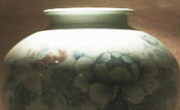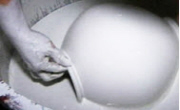분청사기에는 관사명과 지명을 印花 또는 象嵌技法으로 표현한 예가 많은데 이것은 분청사기의 제작연대 및 지방의 특질 등을 연구하는데 있어 많은 도움이 된다. 특히, 官司銘 粉靑沙器는 ...
http://chineseinput.net/에서 pinyin(병음)방식으로 중국어를 변환할 수 있습니다.
변환된 중국어를 복사하여 사용하시면 됩니다.
- 中文 을 입력하시려면 zhongwen을 입력하시고 space를누르시면됩니다.
- 北京 을 입력하시려면 beijing을 입력하시고 space를 누르시면 됩니다.
官司銘 粉靑沙器 硏究 : 慶尙道 地域을 중심으로 = (A) study on the Punchong ware engraved the official name : focusing on Gyeong-sang province
한글로보기https://www.riss.kr/link?id=T10085077
- 저자
-
발행사항
부산 : 東亞大學校 大學院, 2004
- 학위논문사항
-
발행연도
2004
-
작성언어
한국어
- 주제어
-
KDC
631.211 판사항(4)
-
발행국(도시)
부산
-
형태사항
vi, 90p. : 삽도 ; 26cm.
-
일반주기명
참고문헌: p. 75-81
- 소장기관
-
0
상세조회 -
0
다운로드
부가정보
국문 초록 (Abstract)
본 연구는 분청사기 중에서도 매우 중요한 위치를 차지하는 관사명 분청사기의 시기 설정과 지역성을 밝혀내는데 논점을 두고 있다. 특히, 상대적으로 연구가 부진한 慶尙道 지역을 중심으로 관사명 분청사기를 연구한 점에 그 의의가 크다고 하겠다. 경상도 지역에는 수많은 요지가 분포되어 있으며 다종다양한 분청사기가 제작된 것으로 잘 알려져 있다.『世宗實錄地理志』慶尙道에는 磁器所 29개 지역에 37개소, 陶器所 27개 지역에 33개소로 총 70개소가 표기되어 있다. 더욱이 上品 자기를 굽던 자기소가 전국 3개 지역의 4개소가 모두 경상도에 있었던 사실은 조선시대 경상도에서의 요업이 매우 발달했음을 시사한다.
경상도 지역 관사명 분청사기는 문양과 장식기법에 있어서는 시기차가 있으며, 관사명 또는 지명의 시문 위치에 있어서는 지역차가 드러나 제작지의 특색을 나타낸다. 또한 관사명 분청사기의 편년을 통하여 그 시기별 특징을 살펴보았는데, 장식기법에 의한 선후시기를 파악한 뒤 유물의 변화과정을 살펴본 결과 관사명 분청사기는 크게 네 시기로 나눌 수 있었다. 시문된 지명 중에는 경상도 지명이 특히 많은 것과 경상도에는 集團連圈文이, 전라도에는 集團菊花文이 발달한 것도 중요한 특징이다. 경상도와 전라도가 비슷한 시기에 인화기법의 절정기를 맞이하여 그릇 가득히 장식하였는데 최근 가마터에서 출토한 유물을 보면 경상도는 여러 개 도장이 한 단위인 집단연권문이 발달한 반면, 전라도는 단독인화문을 기면 가득히 시문하여 좋은 대조를 이룬다.
경상도 지역 관사명 분청사기의 운영기에 있어 문제가 되는 하한시기는 여러 문헌기록과 남아있는 자료를 통하여 추정하였다. 관사명 분청사기를 생산하는 가마는 경기도 廣州를 중심으로 世祖年間에 司饔院의 分院이 설치되면서 급격히 줄었으며, 지방의 일부 가마에서만 지방 관아에 공급할 공납자기를 소량 제작한 것으로 보인다. 이는 분원이 관요적 성격을 띠면서 더 이상 토산공물로서의 분청사기가 필요하지 않았던 것으로 판단된다. 그리하여 1481년 동국여지승람에 기록된 경상도 지역 가마와 여기서 제작된 것으로 판단되는 粉靑沙器印花文「東來長興庫」銘대접과 粉靑沙器印花文「義興長興庫」銘대접, 그리고 1477년까지 長興庫가 존속한 기록을 통하여 관사명 분청사기의 하한시기는 1481년경으로 파악하였다.
분청사기에는 관사명과 지명을 印花 또는 象嵌技法으로 표현한 예가 많은데 이것은 분청사기의 제작연대 및 지방의 특질 등을 연구하는데 있어 많은 도움이 된다. 특히, 官司銘 粉靑沙器는 관사의 존속기간이 있어 어느 정도 그 시기를 추정할 수 있으므로 매우 중요한 자료로 평가받고 있다. 관사명을 새기게 된 동기는 太宗 17년(1417)의 기록을 통해, 관물을 훔쳐 사용하는 것을 막기 위해 각 관사에 상납되는 그릇에는 그 관사의 이름을 새기게 했음을 알 수 있다. 그런데 이중에는 일정 기간 동안 존속되다가 없어지는 관사가 있기 때문에 분청사기 연구의 편년 기준이 되며, 또한 당시의 요업 상황을 잘 알려준다. 그러나 지금까지 관사명 분청사기에 관한 연구는 관사명의 종류와 특징만을 중심으로 진행되어 왔을 뿐 구체적인 연구는 이뤄지지 않은 상태이다.
본 연구는 분청사기 중에서도 매우 중요한 위치를 차지하는 관사명 분청사기의 시기 설정과 지역성을 밝혀내는데 논점을 두고 있다. 특히, 상대적으로 연구가 부진한 慶尙道 지역을 중심으로 관사명 분청사기를 연구한 점에 그 의의가 크다고 하겠다. 경상도 지역에는 수많은 요지가 분포되어 있으며 다종다양한 분청사기가 제작된 것으로 잘 알려져 있다.『世宗實錄地理志』慶尙道에는 磁器所 29개 지역에 37개소, 陶器所 27개 지역에 33개소로 총 70개소가 표기되어 있다. 더욱이 上品 자기를 굽던 자기소가 전국 3개 지역의 4개소가 모두 경상도에 있었던 사실은 조선시대 경상도에서의 요업이 매우 발달했음을 시사한다.
경상도 지역 관사명 분청사기는 문양과 장식기법에 있어서는 시기차가 있으며, 관사명 또는 지명의 시문 위치에 있어서는 지역차가 드러나 제작지의 특색을 나타낸다. 또한 관사명 분청사기의 편년을 통하여 그 시기별 특징을 살펴보았는데, 장식기법에 의한 선후시기를 파악한 뒤 유물의 변화과정을 살펴본 결과 관사명 분청사기는 크게 네 시기로 나눌 수 있었다. 시문된 지명 중에는 경상도 지명이 특히 많은 것과 경상도에는 集團連圈文이, 전라도에는 集團菊花文이 발달한 것도 중요한 특징이다. 경상도와 전라도가 비슷한 시기에 인화기법의 절정기를 맞이하여 그릇 가득히 장식하였는데 최근 가마터에서 출토한 유물을 보면 경상도는 여러 개 도장이 한 단위인 집단연권문이 발달한 반면, 전라도는 단독인화문을 기면 가득히 시문하여 좋은 대조를 이룬다.
경상도 지역 관사명 분청사기의 운영기에 있어 문제가 되는 하한시기는 여러 문헌기록과 남아있는 자료를 통하여 추정하였다. 관사명 분청사기를 생산하는 가마는 경기도 廣州를 중심으로 世祖年間에 司饔院의 分院이 설치되면서 급격히 줄었으며, 지방의 일부 가마에서만 지방 관아에 공급할 공납자기를 소량 제작한 것으로 보인다. 이는 분원이 관요적 성격을 띠면서 더 이상 토산공물로서의 분청사기가 필요하지 않았던 것으로 판단된다. 그리하여 1481년 동국여지승람에 기록된 경상도 지역 가마와 여기서 제작된 것으로 판단되는 粉靑沙器印花文「東來長興庫」銘대접과 粉靑沙器印花文「義興長興庫」銘대접, 그리고 1477년까지 長興庫가 존속한 기록을 통하여 관사명 분청사기의 하한시기는 1481년경으로 파악하였다.
다국어 초록 (Multilingual Abstract)
This thesis concentrate upon the subject that is examined about a time establish and local characteristic of Punchong ware engraved the official name among the rest. Especially it is very significant to study it because it is weakly researched in Gyeong-Sang province by comparison. A great many kilns are distributed in it, it is known that the various Punchong wares are produced.
The Punchong wares in Gyeong-Sang province have the time difference in the patterns and decoration techniques, the characteristic of the producing place in the position engraved the official name and area. Besides Punchong wares engraved the official name are divided with four chronological times after I examined orders in the decoration techniques, change processes of these. It is a main point that there are most name of Gyeong-Sang province among the wares engraved, patterns of lotus flowers group are advancd in Gyeong-Sang province and it of chrysanthemums group in Jeon-La province too. when Gyeong-Sang province and Jeon-La province have a peak of techniques stamped floral design in the similar time, all Punchong ware is filled with it. Recently when I look into the materials excavated in the kiln, patterns of lotus flowers group, a unit of stamps, are developed in Gyeong-Sang province, on the other side all surface of ware is filled with single floral design stamped in Jeon-La province. That is a good contrast.
A problem relating to the lowest time limit of Punchong ware under operation is solved with documentary records and materials. After the 1469, it is written on the Sejoyeongan(世祖年間) that a branch building of a Saongwon(司饔院) is founded with the center of Kwangju in Kyoungki province, the kiln producing Punchong ware engraved the official name decreases and a little tribute porcelains are just made in some provincial kiln. In this point this branch building has a distinguishing mark of the official kiln, I think, any more Punchong wares as the local tribute porcelains don't need. I suggest that a bowl engraved is produced till this time. Because a bowl engraved Dongraejangheunggo(東萊長興庫), and a bowl engraved Uiheungjangheungg(義興長興庫), Punchong stamped floral design are made in the records of Seongjong's true record(成宗實錄) about Jangheunggo(長興庫) in 1499 and Dongkukyeogiseungrok(東國輿地勝覽) in 1481. The others, when the official and regional name of floral design painted with iron and kwiyal mun technique remain, it is concluded that the Punchong ware engraved the official name continues before Bunjang technique appears in 1540s.
There are many examples of the Punchong ware engraved the official and region name by floral design stamped or inlaying techniques, it is very useful to study the production age and the local characteristic of the Punchong ware. Especially it is impor...
There are many examples of the Punchong ware engraved the official and region name by floral design stamped or inlaying techniques, it is very useful to study the production age and the local characteristic of the Punchong ware. Especially it is important that the Punchong ware engraved the official name can be assumed to check the age. The purpose to engrave the official name on the Punchong ware is to prevent stealing the wares that is paid to the authorities according to a record of Tae-Jong 17 years (1417). However it is useful to study a chronological standard because an official residence continued to exist at the regular time, sometimes disappeared. It provide with a information about the ceramic industry in that time. It is not examined concretely, but a study on the Punchong ware has just focused on the kind and characteristic up the present.
This thesis concentrate upon the subject that is examined about a time establish and local characteristic of Punchong ware engraved the official name among the rest. Especially it is very significant to study it because it is weakly researched in Gyeong-Sang province by comparison. A great many kilns are distributed in it, it is known that the various Punchong wares are produced.
The Punchong wares in Gyeong-Sang province have the time difference in the patterns and decoration techniques, the characteristic of the producing place in the position engraved the official name and area. Besides Punchong wares engraved the official name are divided with four chronological times after I examined orders in the decoration techniques, change processes of these. It is a main point that there are most name of Gyeong-Sang province among the wares engraved, patterns of lotus flowers group are advancd in Gyeong-Sang province and it of chrysanthemums group in Jeon-La province too. when Gyeong-Sang province and Jeon-La province have a peak of techniques stamped floral design in the similar time, all Punchong ware is filled with it. Recently when I look into the materials excavated in the kiln, patterns of lotus flowers group, a unit of stamps, are developed in Gyeong-Sang province, on the other side all surface of ware is filled with single floral design stamped in Jeon-La province. That is a good contrast.
A problem relating to the lowest time limit of Punchong ware under operation is solved with documentary records and materials. After the 1469, it is written on the Sejoyeongan(世祖年間) that a branch building of a Saongwon(司饔院) is founded with the center of Kwangju in Kyoungki province, the kiln producing Punchong ware engraved the official name decreases and a little tribute porcelains are just made in some provincial kiln. In this point this branch building has a distinguishing mark of the official kiln, I think, any more Punchong wares as the local tribute porcelains don't need. I suggest that a bowl engraved is produced till this time. Because a bowl engraved Dongraejangheunggo(東萊長興庫), and a bowl engraved Uiheungjangheungg(義興長興庫), Punchong stamped floral design are made in the records of Seongjong's true record(成宗實錄) about Jangheunggo(長興庫) in 1499 and Dongkukyeogiseungrok(東國輿地勝覽) in 1481. The others, when the official and regional name of floral design painted with iron and kwiyal mun technique remain, it is concluded that the Punchong ware engraved the official name continues before Bunjang technique appears in 1540s.
목차 (Table of Contents)
- 국문초록 = ⅰ
- 目次 = ⅲ
- Ⅰ. 머리말 = 1
- Ⅱ. 官司銘의 종류와 文獻記錄 = 4
- 1. 종류와 銘文書式 = 4
- 국문초록 = ⅰ
- 目次 = ⅲ
- Ⅰ. 머리말 = 1
- Ⅱ. 官司銘의 종류와 文獻記錄 = 4
- 1. 종류와 銘文書式 = 4
- 2. 文獻에 보이는 官司銘 記事 = 13
- Ⅲ. 慶尙道 地域 粉靑沙器 출토유적과 유물의 양상 = 15
- 1. 유적분포와 개요 = 15
- 2. 기종과 기형 = 29
- 3. 문양과 기법, 번조수법 = 30
- 4. 관사명 분청사기와 일반 분청사기 비교 = 41
- Ⅳ. 慶尙道 地域 官司銘 粉靑沙器의 시기성과 지역성 = 46
- 1. 시기성 = 46
- 2. 지역성 = 54
- Ⅴ. 慶尙道 地域 官司銘 粉靑沙器의 運營期와 의의 = 56
- 1. 15世紀 慶尙道 地域의 窯業 상황 = 56
- 2. 官司銘 粉靑沙器의 運營期 문제 = 69
- Ⅵ. 맺음말 = 72
- 參考文獻 = 75
- 사진 = 82
- ABSTRACT = 88












